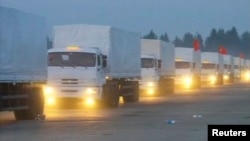The Kremlin's August 11 announcement that it would be sending "humanitarian aid" to Ukraine has set off a dizzying round of geopolitical telephone.
And as a Russian convoy with 280 trucks rumbled from Moscow toward the border with Ukraine, the flurry of statements had done little to clarify what Ukraine and Russia, along with Western leaders and the International Committee of the Red Cross (ICRC), had actually agreed to.
Here's what we know so far:
Agreement On Aid
Following the statement on Russian President Vladimir Putin's website, which claimed that the Russian convoy would be sent in collaboration with the Red Cross, Russian Foreign Minister Sergei Lavrov said Ukraine had agreed to "all details."
After a phone call with U.S. President Barack Obama, Ukrainian President Petro Poroshenko announced on his website that he had indeed agreed to an international humanitarian mission. The operation, which he claimed was his own initiative, was to be led by the Red Cross and would include cooperation from the European Union, Germany, and Russia. (While the statement remains on the website, the wording listing partner countries had disappeared.)
The Red Cross, for its part, said there was "agreement by all sides that the ICRC will be allowed to deliver the aid with due respect for its fundamental working principles of neutrality, impartiality, and independence." It also stipulated that all Russian humanitarian assistance would need to be handed over to the Red Cross itself.
Coordinated Aid?
But as the Russian fleet moved toward Ukraine, it had become apparent that despite the communiques less than 12 hours earlier, there had been little coordination.
The Red Cross told RFE/RL that the aid convoy was not theirs and they did not know what was in it.
"We don't yet know entirely what's in it. We are waiting to clarify some practical details before moving forward with this aid convoy," Ewan Watson, a spokesman for the Red Cross, told RFE/RL. "At the moment it is not an International Red Cross convoy, inasmuch as we haven't had sight of the material, we haven't had certain information regarding the content, and the volume of aid that it contains." He said that the ICRC was not informed by the Russians that it had left until after it departed.
Fears Of A Russian incursion
The statements on aid come against the backdrop of increasing fears over a potential full-scale Russian invasion of Ukraine. There are as many as 20,000 Russian military personnel on Ukraine's border, and some have speculated that Moscow would use "humanitarian intervention" as a pretext for its incursion.
Shortly before Moscow's August 11 announcement, NATO Secretary-General Anders Fogh Rasmussen said there was "high probability" that Russia would take unilateral military action "under the guise of a humanitarian operation."
It is with this in mind that Western statements -- including those from the European Union and United States stressed the need for any aid operation to be led by the Red Cross (and not Russia).
Painted White Trucks
The first pictures of Russia's convoy, which appeared in Russian state media early on August 12, did little to allay the fears.
Heading toward Luhansk from just outside Moscow, Russian authorities said the 280 trucks carrying 2,000 tons of food, medicine, medical equipment, sleeping bags, and power generators would arrive in the embattled eastern Ukrainian region of Luhansk by the morning of August 13.
While Russian news agencies reported that the trucks were coming from Russia's Emergency Situations Ministry, Russian bloggers quickly pointed out that the automobiles appeared to be repainted versions of green Russian military trucks.
A video uploaded to YouTube on August 10 appeared to show similar trucks surrounded by Russian soldiers -- some were green, while others appeared to have a fresh coat of white paint. And the "Kyiv Post" reported that some Russian soldiers had apparently posted messages on social media about repainting and stocking trucks with aid.
Where Is The Aid Headed And Who's Taking It There?
Ostensibly, the supplies are headed to territories in the Ukrainian region of Luhansk that since April have been occupied by armed pro-Russian separatists.
Amid heavy fighting between separatists and Kyiv's armed forces -- and with both sides accused of indiscriminate shelling -- the southeastern part of the region, which includes its largest city, Luhansk, has been almost completely cut off.
According to the Red Cross, thousands are without access to water, electricity, or medicine.
But with strong evidence that Russia has provided arms and support to separatists, Kyiv would be unlikely to allow an uncoordinated convoy of Russian trucks to enter the region -- even if the vehicles were carrying only aid.
At least three high-ranking Ukrainian officials, apparently alarmed by the fast-paced developments on the Russian side, have warned that the convoy will not be allowed to pass through Ukraine's borders.
Valeriy Chaliy, Poroshenko's chief of staff, told news media that Ukraine was "not considering" giving the trucks access to Ukrainian territory and a Ukrainian military spokesman said the Red Cross would need a week to determine Luhansk's needs.
Russia, so far, has dismissed those concerns.
A Foreign Ministry statement, which called Ukrainian concerns "puzzling," said the convoy would enter Ukraine at the Belgorod-Kharkiv crossing "under the auspices of the International Committee of the Red Cross."
Earlier, a spokesperson for Russia's Emergency Ministry had reportedly told BBC that the convoy had no plans to enter Ukraine.










